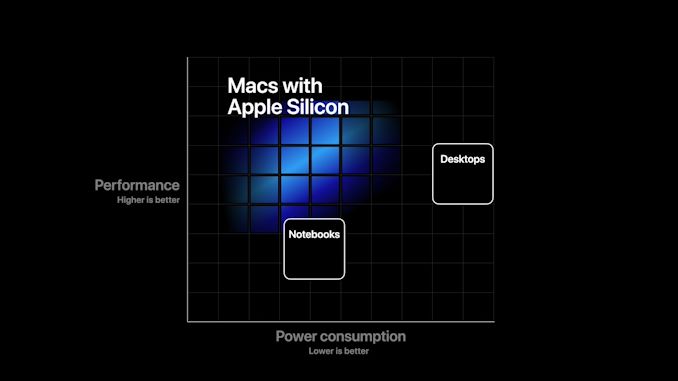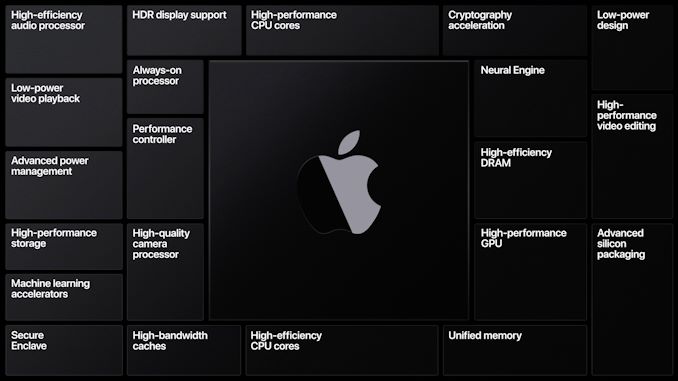Apple Announces Event for November 10th: Arm-Based Macs Expected
by Ryan Smith on November 2, 2020 12:30 PM EST
We don’t normally publish news posts about Apple sending out RSVPs for product launch events, but this one should be especially interesting.
This morning Apple has sent notice that they’re holding an event next Tuesday dubbed “One more thing.” In traditional Apple fashion, the announcement doesn’t contain any detailed information about the content expected; but as Apple has already announced their updated iPads and iPhones, the only thing left on Apple’s list for the year is Macs. Specifically, their forthcoming Arm-powered Macs.
As previously announced by Apple back at their summer WWDC event, the company is transitioning its Mac lineup from x86 CPUs to Arm CPUs. With a two-year transition plan in mind, Apple is planning to start the Arm Mac transition this year, and wrapping things up in 2022.
For the new Arm Macs, Apple will of course be using their own in-house designed Arm processors, the A-series. As we’ve seen time and time again from the company, Apple’s CPU design team is on the cutting-edge of Arm CPU cores, producing the fastest Arm CPU cores for several years running now, and more recently even overtaking Intel’s x86 chips in real-world Instruction Per Clock (IPC) rates. Suffice it to say, Apple believes they can do better than Intel by designing their own CPUs, and especially with the benefits of vertical integration and total platform control, they might be right.
Apple has been shipping early Arm Macs to developers since the summer, using modified Mac Minis containing their A12Z silicon. We’re obviously expecting something newer, but whether it’s a variant of Apple’s A14 SoC, or perhaps something newer and more bespoke specifically for their Macs, remains to be seen.
In the meantime, because this is a phased transition, Apple will be selling Intel Macs – including new models – alongside the planned Arm Macs. So although Apple will no doubt focus on their new Arm Macs, I wouldn’t be the least bit surprised to see some new Intel Macs announced alongside them. Apple will be supporting Intel Macs for years to come, and in the meantime they need to avoid Osborning their x86 systems.
As always, we’ll have a live blog of the events next Tuesday, along with a breakdown of Apple’s announcements afterwards. So please be sure to drop in and check that out.
Source: Apple












66 Comments
View All Comments
azfacea - Tuesday, November 3, 2020 - link
you've confused cheap w/ good graphics. Mac offer existing 2x 4x Radeon GPUs w/ huge amounts of HBM2 on the high end and that radeon was always way better at compute than it was at gaming.Other than gaming perf compared to 1080 Ti or RTX 2080 Ti macs have been quite fine w/ graphics. If you are complaining about value or price, i have bad news for you. its not just the graphics.
azfacea - Tuesday, November 3, 2020 - link
beside NVIDIA not owning ARM at the moment, Apple's problem was w/ NVIDIA not ARM. They had even bigger issues w/ NVIDIA than w/ qualcomm. if anything this purchase should drive apple away from ARM not drive them into NVIDIA. Not saying it will, i am saying thats the only political effect here and its not one of attraction but repellant.Apple will not move away from ARM, as it already uses not ARM but its own architecture. The ARM ISA is fairly open and apple has permanent irrevocable license.
azfacea - Tuesday, November 3, 2020 - link
also in case you didnt here the news recently RDNA 2 pretty much caught up w/ nvidia even in gaming, and RDNA2 products will hit the market a lot sooner than NVIDIA ARM deal completes. if it completes at all.nandnandnand - Monday, November 2, 2020 - link
Bloomberg said that these would have 12 cores (8 big, 4 little). A14 has 6 cores (2 big, 4 little).For the ARM Macs they will swap the ratio around to use more performance cores since power constraints are relaxed, and perhaps it will be arranged in 2 DynamIQ clusters, each with 4 big, 2 little.
What I'd like to see in the ARM landscape is some 16-core DynamIQ SoCs (2x clusters with a mix of Cortex-X1+, Cortex-A78+, Cortex-A55+ in each). Not necessarily in smartphones, but maybe in tablets, laptops, single board computers, and/or "ARM desktops".
michael2k - Monday, November 2, 2020 - link
I don't understand why you need 3 different CPUs in a DynamIQ cluster?I imagine for high performance you want something like a pair of 6/2 or a 5/3 design to balance performance and power efficiency.
So with a pair of 6/2 you get a quad core design when maximum power efficiency is needed, and 12 high powered cores and 4 (lower powered lower performance) cores going all out. If ARM's low powered cores aren't powerful enough then you have a pair of 5/3s. What benefit is it to have 3 different cores?
nandnandnand - Monday, November 2, 2020 - link
Die area could be a concern. The Cortex-X1 is around 50% larger than A78 for only around a 20% performance gain.Configurations like 1+3+4 or 2+2+4 are expected. I thought there was a limit of 4 performance cores per cluster but I can't find anything to corroborate that.
https://www.anandtech.com/show/15813/arm-cortex-a7...
https://www.anandtech.com/show/11441/dynamiq-and-a...
michael2k - Monday, November 2, 2020 - link
Okay, but if you need X performance and that takes 6 X1 cores to equal the same performance as 8 A78, you now have a cluster of 6/2 vs 8; also, in comparing the A77, A78, and X1 integer and floating point performance the A78 only saw a 7% increase in performance at the same frequency, where the X1 saw a 30% improvement.https://www.anandtech.com/show/15813/arm-cortex-a7...
Long story short, you'd have to clock an A78 pretty high to hit the 83% performance threshold; far more reasonable to expect only a 7% boost in performance for the A78 vs the 30% boost for the X1.
Anyway, we're talking about ARM desktops; die size really shouldn't be a concern if we're comparing to Intel, AMD, and now Apple desktops.
In other words:
6/2
nandnandnand - Tuesday, November 3, 2020 - link
Turns out I was right about the 4 per cluster limit, but it's just been thrown out of the window for a new core. The Cortex-A78C:https://www.cnx-software.com/2020/11/03/arm-cortex...
dotjaz - Tuesday, November 3, 2020 - link
Who told you it's 4 per cluster? And who told you you were "right"? DynamIQ can do compatible cores in ANY configuration. There's no limit.dotjaz - Tuesday, November 3, 2020 - link
If the implemeters want to, they can even ditch DynamIQ and impement as many cores as they want in a cluster. Especially with Apple and Samsung, they haven't been using DynamIQ at all (although Samsung likely will make the switch).